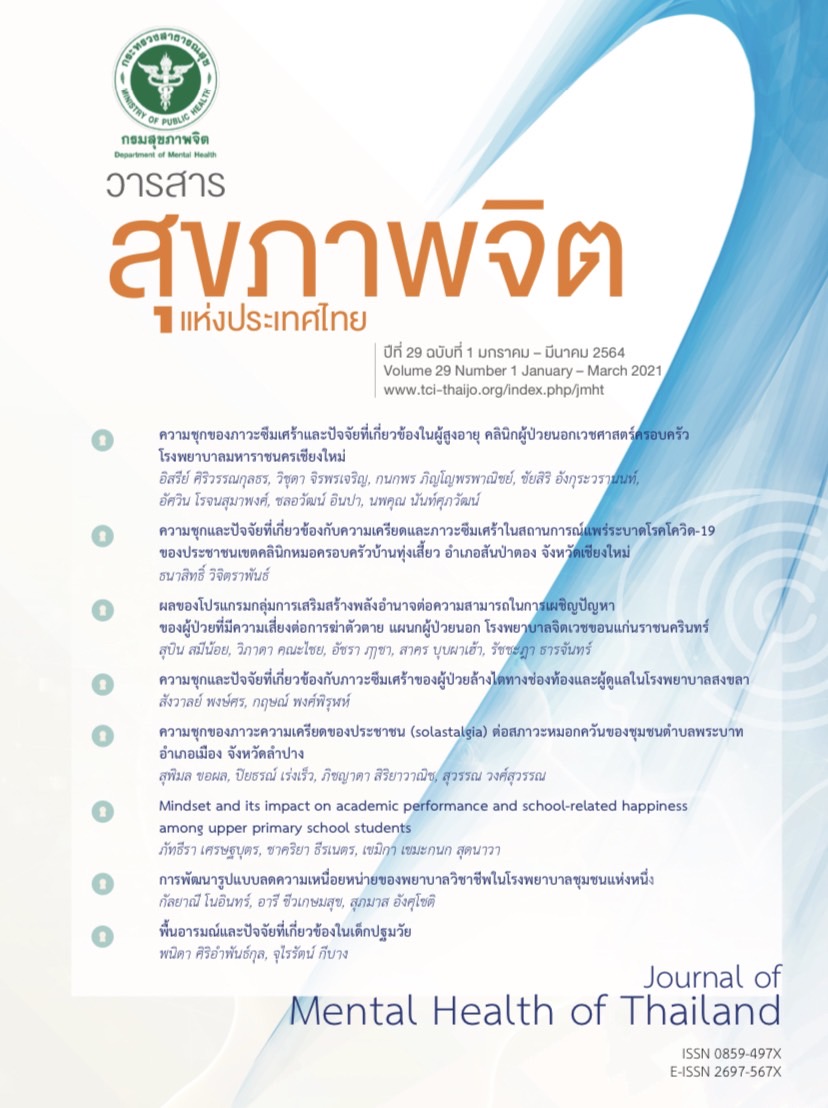พื้นอารมณ์และปัจจัยที่เกี่ยวข้องในเด็กปฐมวัย
คำสำคัญ:
เด็กปฐมวัย, เด็กเลี้ยงง่าย, เด็กเลี้ยงยาก, พื้นอารมณ์บทคัดย่อ
วัตถุประสงค์ : เพื่อศึกษาลักษณะพื้นอารมณ์และปัจจัยที่มีผลต่อพื้นอารมณ์ในเด็กปฐมวัย
วิธีการ : เก็บข้อมูลจากบิดามารดาและเด็กปฐมวัย (อายุ 1 - 5 ปี) จำนวน 444 ครอบครัว ด้วยวิธีสุ่มแบบหลายขั้นตอน จากคลินิกสุขภาพเด็กดีของโรงพยาบาลธรรมศาสตร์เฉลิมพระเกียรติและโรงพยาบาลปทุมธานี และจากศูนย์พัฒนาเด็กเล็กและโรงเรียน 6 แห่ง ในจังหวัดปทุมธานี เครื่องมือที่ใช้ในงานวิจัยเชิงปริมาณ คือ ข้อมูลพื้นฐานของเด็กปฐมวัยและครอบครัว แบบประเมินภาวะโภชนาการเด็ก แบบบันทึกการเฝ้าระวังและส่งเสริมพัฒนาการเด็กปฐมวัย (developmental surveillance and promotion manual: DSPM) และแบบประเมินพื้นอารมณ์เด็กปฐมวัย เครื่องมือที่เก็บข้อมูลเชิงคุณภาพเป็นแนวคำถามและแบบบันทึกการสังเกต วิเคราะห์ข้อมูลใช้สถิติเชิงพรรณนา ร้อยละ ค่าเฉลี่ย และสัมประสิทธิ์สหสัมพันธ์ และวิเคราะห์ข้อมูลคุณภาพด้วยการจัดกลุ่มหัวข้อหรือประเด็น
ผล : เด็กพื้นอารมณ์เลี้ยงง่ายร้อยละ 15.5 เด็กพื้นอารมณ์เลี้ยงยากในบางเรื่อง ร้อยละ 69.1 และเด็กพื้นอารมณ์เลี้ยงยากร้อยละ 15.3 โดยพื้นอารมณ์ด้านครอบครัวพบว่าหัวข้อการเลี้ยงดูมีค่าเฉลี่ยสูงสุด (M = 2.17) ครอบครัวมองว่าการเลี้ยงดูเด็กเป็นงานที่ยุ่งยาก และพื้นอารมณ์ด้านตัวเด็ก พบว่าหัวข้อลักษณะการเคลื่อนไหวมีค่าเฉลี่ยสูงสุด (M = 3.40) เด็กส่วนใหญ่ชอบเล่นโดยการวิ่ง กระโดดหรือปีนป่าย รายได้ครอบครัวมีความสัมพันธ์ทางลบกับค่าเฉลี่ยพื้นอารมณ์เด็กอย่างมีนัยสำคัญทางสถิติที่ระดับ .01
สรุป : เด็กปฐมวัยควรได้รับการคัดกรองพื้นอารมณ์ เพื่อค้นหาเด็กที่มีปัญหาพื้นอารมณ์และให้การช่วยเหลือตั้งแต่ระยะเริ่มต้น
Downloads
เอกสารอ้างอิง
Krueger RF, South S, Johnson W, Iacono W. The heritability of personality is not always 50%: gene-environment interactions and correlations between personality and parenting. J Pers. 2008;76(6):1485-522. doi:10.1111/j.1467-6494.2008.00529.x.
Glynn LM, Howland MA, Sandman CA, Davis EP, Phelan M, Baram TZ, et al. Prenatal maternal mood patterns predict child temperament and adolescent mental health. J Affect Disord. 2018;228:83-90. doi:10.1016/j.jad.2017.11.065.
Zentner M. Identifying child temperament risk factors from 2 to 8 years of age: validation of a brief temperament screening tool in the US, Europe, and China. Eur Child Adolesc Psychiatry. 2020;29(5):665-78. doi:10.1007/s00787-019-01379-5.
Bronfenbrenner U. Toward an experimental ecology of human development. American Psychologist. 1977;32(7),513-31. doi:10.1037/0003-066X.32.7.513.
Klein MR, Lengua LJ, Thompson SF, Moran L, Ruberry EJ, Kiff C, et al. Bidirectional relations between temperament and parenting predicting preschool-age children's adjustment. J Clin Child Adolesc Psychol. 2018;47(sup1):S113-26. doi:10.1080/15374416.2016.1169537.
Sanson A, Hemphill S, Yagmurlu B, McClowry S. Temperament and social development. In: Smith PK, Hart CH, editors. Wiley-Blackwell handbook of childhood social development. Chichester: Wiley-Blackwell; 2011. p. 227-45.
Vassallo S, Sanson A, editors. The Australian Temperament Project: the first 30 years. Melbourne: Australian institute of family studies; 2013.
Nigg JT. Temperament and developmental psychopathology. J Child Psychol Psychiatry. 2006;47(3-4):395-422. doi:10.1111/j.1469-7610.2006.01612.x.
Lahey BB. Commentary: role of temperament in developmental models of psychopathology. J Clin Child Adolesc Psychol. 2004;33(1):88-93. doi:10.1207/S15374424JCCP3301_9.
กรมอนามัย กระทรวงสาธารณสุข. แผนยุทธศาสตร์การพัฒนาระบบส่งเสริมสุขภาพและอนามัยสิ่งแวดล้อม ตามแผนพัฒนาสุขภาพแห่งชาติในช่วงแผนพัฒนาเศรษฐกิจและสังคมแห่งชาติ ฉบับที่ 12 (พ.ศ. 2560-2564) [Strategic plan for the development of health and environmental health promotion system according to the national health development plan during the 12th national economic and social development plan (2017-2021)]. นนทบุรี: กรม; 2554.
Goodnight JA, Donahue KL, Waldman ID, Van Hulle CA, Rathouz PJ, Lahey BB, et al. Genetic and environmental contributions to associations between infant fussy temperament and antisocial behavior in childhood and adolescence. Behav Genet. 2016;46(5):680-92. doi:10.1007/s10519-016-9794-2.
Hasenfratz L, Benish-Weisman M, Steinberg T, Knafo-Noam A. Temperament and peer problems from early to middle childhood: Gene-environment correlations with negative emotionality and sociability. Dev Psychopathol. 2015;27(4):1089-109. doi:10.1017/S095457941500070X.
Micalizzi L, Wang M, Saudino KJ. Difficult temperament and negative parenting in early childhood: a genetically informed cross-lagged analysis. Dev Sci. 2017;20(2):e12355. doi:10.1111/desc.12355.
Scott S, Knapp M, Henderson J, Maughan B. Financial cost of social exclusion: follow up study of antisocial children into adulthood. BMJ. 2001;323(7306):191. doi:10.1136/bmj.323.7306.191.
Super CM, Axia G, Harkness S, Welles-Nyström B, Zylicz PO, Parmar P, et al. Culture, temperament, and the "difficult child": a study in seven western cultures. International Journal of Developmental Sciences. 2008;2(1-2):136-57. doi:10.3233/DEV-2008-21209.
Plomin R, Dunn J, editors. The study of temperament: changes, continuities and challenges [Internet]. New Jersey: Lawrence Erlbaum Associates; 1986. Available from: https://www.gwern.net/docs/genetics/heritable/1986-plomin-thestudyoftemperament.pdf
Friedman MM, Bowden VR, Jones EG. Family nursing: research, theory, and practice. 5th ed. New Jersey: Upper Saddle River; 2003.
กรมอนามัย กระทรวงสาธารณสุข. คู่มือเฝ้าระวังและส่งเสริมพัฒนาการเด็กปฐมวัย [Developmental Surveillance and Promotion Manual (DSPM)]. นนทบุรี: สำนักงานกิจการโรงพิมพ์องค์การส่งเคราะห์ทหารผ่านศึก; 2560.
พนิดา ศิริอำพันธ์กุล. ประสบการณ์ชีวิตของบิดามารดาที่มีลูกเลี้ยงยากวัยเตาะแตะ [Lived experiences of parents having difficult toddler] [วิทยานิพนธ์ปริญญาดุษฎีบัณฑิต]. ชลบุรี: มหาวิทยาลัยบูรพา; 2556.
Polit DF, Beck CT, Hungler BP, Hungler BP. Essentials of nursing research: appraisal and utilization. Philadelphia: Lippincott Williams & Wilkins; 2001.
จินตนา พัฒนพงศ์ธร, ชัยชนะ บุญสุวรรณ, นฤมล ธนเจริญวัชร. ผลการศึกษาพัฒนาการเด็กปฐมวัยไทย [The study of Thai early child development]. นนทบุรี: สำนักส่งเสริมสุขภาพ กรมอนามัย; 2558.
วิชัย เอกพลากร, บรรณาธิการ. การสำรวจสุขภาพประชาชนไทยโดยการตรวจร่างกายครั้งที่ 5 พ.ศ. 2557 ฉบับสุขภาพเด็ก [อินเทอร์เน็ต]. กรุงเทพฯ: สถาบันวิจัยระบบสาธารณสุข; 2559. [สืบค้นเมื่อวันที่ 20 พ.ย. 2563]. จาก: https://www.hiso.or.th/hiso/picture/reportHealth/report/thai2014kid.pdf
นพร อึ้งอาภรณ์. โครงการการศึกษาภาวะโภชนาการเด็กวัยก่อนเรียนในเขตพื้นที่รอบมหาวิทยาลัยเทคโนโลยีสุรนารี [Nutritional status in preschool children in area of Suranaree university of technology]. นครราชสีมา: สำนักวิชาแพทยศาสตร์ มหาวิทยาลัยเทคโนยีสุรนารี; 2556.
Thomas A, Chess S, Birch HG. The origin of personality. Sci Am. 1970;223(2):102-9. doi:10.1038/scientificamerican0870-102.
Koblinsky SA, Kuvalanka KA, Randolph SM. Social skills and behavior problems of urban, African American preschoolers: role of parenting practices, family conflict, and maternal depression. Am J Orthopsychiatry. 2006;76(4):554-63. doi:10.1037/0002-9432.76.4.554.
Ann Del'Homme M, Sinclair E, Kasari C. Preschool children with behavioral problems: observation in instructional and free play contexts. Behavioral Disorders. 1994;19(3):221-32.
Keenan K, Wakschlag LS. Can a valid diagnosis of disruptive behavior disorder be made in preschool children?. Am J Psychiatry. 2002;159(3):351-8. doi:10.1176/appi.ajp.159.3.351.
Keenan K, Wakschlag LS, Danis B, Hill C, Humphries M, Duax J, et al. Further evidence of the reliability and validity of DSM-IV ODD and CD in preschool children. J Am Acad Child Adolesc Psychiatry. 2007;46(4):457-68. doi:10.1097/CHI.0b013e31803062d3.
ดาวน์โหลด
เผยแพร่แล้ว
รูปแบบการอ้างอิง
ฉบับ
ประเภทบทความ
สัญญาอนุญาต
- ผู้อ่านสามารถนำข้อความ ข้อมูล จากวารสารไปใช้ไปใช้ประโยชน์ทางวิชาการได้ เช่น เพื่อการสอน เพื่อการอ้างอิง แต่การนำไปใช้เพื่อวัตถุประสงค์อื่น เช่น เพื่อการค้า จะต้องได้รับอนุญาตเป็นลายลักษณ์อักษรจากกรมสุขภาพจิตก่อน
- ความคิดเห็น ข้อมูล และบทสรุปต่าง ๆ ที่ลงตีพิมพ์ในวารสารสุขภาพจิตแห่งประเทศไทยเป็นของผู้เขียนบทความและมิได้แสดงว่ากองบรรณาธิการหรือกรมสุขภาพจิตเห็นพ้องด้วย




